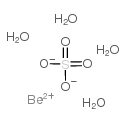Hydration of beryllium(II) in aqueous solutions of common inorganic salts. A combined vibrational spectroscopic and ab initio molecular orbital study.
Wolfram W Rudolph, Dieter Fischer, Gert Irmer, Cory C Pye
文献索引:Dalton Trans. (33) , 6513-27, (2009)
全文:HTML全文
摘要
Raman spectra of aqueous beryllium perchlorate, chloride, nitrate, and sulfate solutions have been measured over a broad concentration (0.098-4.950 mol L(-1)) range. The Raman spectroscopic data suggest that the tetra-aqua beryllium(II) ion is thermodynamically stable in perchlorate, chloride, and nitrate solutions over the concentration range measured. No inner-sphere complexes in these solutions could be detected spectroscopically except in very concentrated beryllium nitrate solutions. Beryllium sulfate solutions however, show a different picture, namely the existence of a thermodynamically stable beryllium sulfato complex most likely monodentate even at very low concentrations. At very high beryllium sulfate concentrations, a small quantity of a bidentate sulfato complex was found. With a temperature increase, the sulfato complex formation increases and this demonstrates the entropically driven sulfato complex formation. Furthermore, with increased temperature the hydrolysis increases, measured by the formation of hydrogen sulfate. Ab initio geometry optimizations and frequency calculations are reported for beryllium-water clusters with only inner sphere waters, clusters with an inner sphere and an incomplete second hydration, and clusters with a higher number of waters in the second hydration sphere. The cluster, [Be(OH2)(12)(2+)] (Be[4 + 8]) with 4 water molecules in the first sphere and 8 water molecules in the second sphere gave sufficiently realistic frequencies for BeO4 skeleton in comparison to the experimental ones. However, the cluster, [Be(OH2)(18)(2+)] (Be[6 + 12]) with 6 water molecules in the inner sphere and 12 water molecules in the outer sphere on an energy minimum gave unrealistically low BeO4 frequencies. This fact demonstrates that a six-fold coordination of Be2+ can be ruled out.
相关化合物
| 结构式 | 名称/CAS号 | 分子式 | 全部文献 |
|---|---|---|---|
 |
硫酸铍
CAS:7787-56-6 |
BeH8O8S | |
 |
硝酸铍
CAS:13597-99-4 |
BeN2O6 |
|
[Diagnosis of chronic berylliosis].
1999-04-01 [Pneumologie 53(4) , 193-8, (1999)] |
|
Beryllium-stimulated release of tumor necrosis factor-alpha,...
1997-12-01 [Am. J. Respir. Crit. Care Med. 156(6) , 1884-91, (1997)] |
|
Target organ localization of memory CD4(+) T cells in patien...
2002-11-01 [J. Clin. Invest. 110(10) , 1473-82, (2002)] |
|
Beryllium presentation to CD4+ T cells underlies disease-sus...
2000-11-07 [Proc. Natl. Acad. Sci. U. S. A. 97(23) , 12717-22, (2000)] |
|
Divergent effect of cobalt and beryllium salts on the fate o...
2011-02-01 [Toxicol. Sci. 119(2) , 257-69, (2011)] |